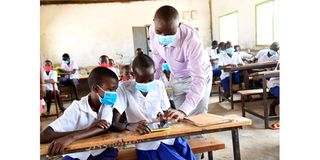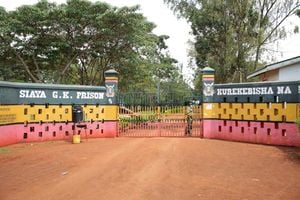Best start to life: Digital tools ‘equalise’ learning

Teacher Justus Mwangangi giving instructions to Standard 8 pupil Millan Akelu (centre) and Standard 6 pupil Japheth Nakayen during a digital learning session at Namoruputh Primary School in Turkana County
There were times, before 2020, when digital learning felt like an unattainable goal for pupils and teachers of Namoruputh Primary School in Turkana county.
Located in a remote corner of the vast county that borders Uganda and surrounded by hills, the school had no internet connectivity.
It depended – and still does – on solar panels with faulty batteries.
Because of that, most of the lessons were theory.
But questions to teachers kept flooding: Where is Nyayo National Stadium? Does Nairobi experience flooding? Which teams won the Kenya and English Premier Leagues?
“Namoruputh School is more than 70 kilometres from Lodwar, Turkana county headquarters. Most of our pupils have never been there. They used to imagine what a big city like Nairobi looked liked and asked many questions,” Mr Justus Mwangangi, head of ICT at the school, says.
“We had to explain in detail everything beyond Namoruputh in almost all the lessons. It was complicated.”
The sun feels closer here, more intense and personal. As heat waves dance up the dry floor for as far as the eye can see, dozens of learners huddle at a makeshift Information Communication and Technology (ICT) room.
Except for the power socket, everything else resembles a typical classroom – desks and a blackboard.
Mr Mwangangi is taking the pupils through a lesson on the political development of the Khoikhoi and San in southern Africa.
However, instead of reading aloud from their textbooks, he directs them to power their tablets and to the search engines they can see images and videos related to the lesson.
It is an interactive class drawn to help learners expand their worldview.
Namoruputh is one of the 110 schools connected to the internet since 2020 by Unicef, the government and partners as part of the Giga project.
“The aim of the Unicef Reimagine Education Initiative is to revolutionise learning and foundational skills and provide quality education to every child, including through internet connectivity and digital learning,” says Rotuno Kipsang, Unicef chief of the field office in Lodwar.
“We want to ensure the child in Turkana can have equal access to education and improve literacy levels in the region. Internet penetration was just 23 per cent in 2019. We hope the next government will connect all schools to the internet, provide up-to-date digital learning content and support digital literacy.”
To fully understand the impact of digital learning on these children, you would need to immerse yourself into the challenges they face daily.
In a 2020 report by the Kenya National Bureau of Statistics (KNBS) and the University of Nairobi, Turkana – the second largest county in Kenya in terms of land mass – was ranked the poorest and most unequal.
More than 70 per cent of families in Turkana county cannot meet basic needs like food, shelter, clothing and education for their children.
This inadequacy also translates to the exposure the children get.
In this ICT class, for instance, only a handful of learners have stepped out of Turkana county. The tablets are a learning lifeline to the youngsters.
Ukraine war
Namoruputh Primary School head Peter Abei says teachers have noted an improvement in many aspects of the pupils’ lives from the time the institution was connected to the internet two years ago.
“It has greatly transformed teaching and learning. The internet has reduced the struggle to explain things that many children thought were abstract,” Mr Abei says.
“They can now access photographs, charts, maps and news in the comfort of their classrooms. Many pupils have become more responsible academically. Namoruputh is the top school academically in the sub-county and learners can now dream of careers besides the common list. However, there is a problem with the bandwidth. Lessons keep getting interrupted because of poor network.”
Kenya Primary School Headteachers Association (KEPSHA) chairman Johnson Nzioka admits getting positive feedback from heads whose schools are connected to the internet.
“The introduction of digital learning has made school interesting and created an exciting environment for children,” Mr Nzioka says.
“It has enhanced efficient curriculum delivery. Most headteachers who talk to me say academic performance of their schools has improved.”
Learners at Namoruputh School school come from as far as 100 kilometres away.
Mr Abei says with the provision of tablets, pupils are enthusiastic and classes are recording more than double the numbers registered seven years ago.
Learning has been simplified and teachers and pupils are motivated.
“Namoruputh Primary School has more than 500 pupils and only nine teachers,” Mr Abei says.
After the lesson, the children walk excitedly out of the classroom.
Some group themselves to play football while others engage in light conversations about their recent discoveries on the internet.
To protect the devices from damage or loss, they are kept away under lock and key after the lessons.
According to Mr Mwangangi, the internet has revolutionised learning in school and at home.
“When we got connected to the internet and our pupils started to follow topics online, many parents showed interest in the internet. They wanted to know the devices and how they work,” Mr Mwangangi says.
“Some asked: ‘What is this that we have heard about online learning?’ Encouraged by what their children had discovered, coupled with improvement in academic performance, some bought smartphones to facilitate learning at home.”
Simon Lopeyok, 13, a 2022 Kenya Certificate of Primary Education (KCPE) examination candidate, says the internet has helped him to study and revise his work.
“The tablet has improved my learning, especially in subjects like science. For experiments we cannot carry out in class, I watch them online and observe the results,” Lopeyok says.
“I also know what is happening in other parts of the world. I have read Kenya’s stand on the war between Ukraine and Russia. I can also tell the progress of the English Premier League. I play football at break time. Through online learning, I look for tips to increase speed, strength and how to shoot the ball. My friends say I have become a better player. I love current affairs, things you cannot find in text books.”
Thirteen-year-old Millan Akeru, also in Standard Eight, says the internet has enabled her to “travel”, to many places in the world.
“When in Namoruputh, you can use Google to tell how places like Addis Ababa in Ethiopia look like. We are able to read and learn together even when the teacher is not in class,” she says.
The farthest Akeru has physically gone is Lodwar yet she can paint images of many places in the country, thanks to digital learning.
When schools were partially closed in 2020 due to the coronavirus pandemic, about a third of the world’s schoolchildren – some 463 million – could not access remote learning, according to a Unicef report released last year as countries grappled with back-to-school plans.
The report outlines the limitations of remote learning and inequalities in access.
One of the challenges Namoruputh pupils face, a situation replicated in most parts of Turkana county, is that they cannot learn digitally outside of their school.
“Solar panels were installed five years ago but have faulty batteries. Our lessons keep getting interrupted and sometimes, a session that would have taken half an hour spills to more than an hour because of power challenges,” Mr Abei says.
“Even if we were to allow the children to take the tablets home for continuous learning, most households have no access to a source of power like electricity or solar.”
Many children could not access remote learning and were forced into marriages and work during the nine months of school closure.
Thousands of children did not return to school after the reopening.
Seeing the transformation of the pupils just two years after Namoruputh School was connected to the internet through a local service provider, learners, their teachers and the community now say continued access to digital lessons will level the playing field between them and children in other parts of Kenya.
They are calling on Turkana county leaders to ensure continued access to digital learning and quality education.
“We strongly believe that digital learning is not a thing of the future but one that should be fully embraced today. Apart from learning, it gives pupils a leg up in the future,” says Mr Mwangangi who is also a missionary posted to the region by Christ is the Answer Ministries.
Mr Kipsang says Unicef if engaging aspirants for elective county and national seats on six issues.
“One of our pleas is that we want them to commit to enhancing digital learning as that will help the children be global citizens. The other matters are social protection, ending violence against children, investing in areas of climate change, proper nutrition and primary and community health,” he says.





